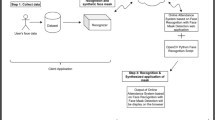Abstract
This paper suggests novel proposed cancellable biometric realization technique recognition and template protection. This algorithm is based on encrypt data securely with the benefits of graph theory properties. The new symmetric encryption algorithm utilizes the concepts of bipartite graph to generate a complex cipher text using a shared key. In this paper, the Graph First Decomposition Mask (GFH) encoding algorithm is utilized for cancelable face system. In the suggested scheme, the GFH algorithm is applied on the face images. The resultant map is encrypted, in order to the second GFH utilized in production from the picture. This scheme can be used to develop a frequency domain procedure for making this system for biometric template protection. Simulation results using evaluation metrics False Positive Rate (FPR), False Negative Rate (FNR), Equal Error Rate (EER), Receiver Operating Characteristic (ROC) and Area under ROC (AROC) prove that the proposed cancelable biometric technique is the best performance with comparing the other techniques.The obtained results clear that the suggested technique has sucesseded in cancelable face biometric.












Similar content being viewed by others
References
Akl SG (2019) The graph is the message: design and analysis of an unconventional cryptographic function. Technical Report 2018–635. In: Book: From Parallel to Emergent Computing, eBook ISBN 9781315167084, pp. 18
Amudha P, Sagayaraj AC, Sheela AS (2018) An application of graph theory in cryptography. Int J Pure Appl Math 119(13):375–383
Ashiba HI (2021) Proposed framework for cancelable face recognition system. Multimed Tools Appl 80:13677–13705. https://doi.org/10.1007/s11042-020-10291-z
Ashiba HI, El-Samie FEA (2020) Implementation face based cancelable multi-biometric system. Multimed Tools Appl 79:30813–30838. https://doi.org/10.1007/s11042-020-09529-7
Bordel B, Alcarria R, Martín D, Sánchez-de-Rivera D (2020) An agent-based method for trust graph calculation in resource constrained environments. Integr Comput Aided Eng 27(1):37–56
Cheung K, Kong A, You J, Zhang D (2005) An analysis on invertibility of cancelable biometrics based on BioHashing. International Conference on Imaging Science, Systems, and Technology, pp. 40–45
Connie T, Teoh A, Goh M, Ngo D (2004) Palm Hashing: a novel approach to cancelable biometrics. Inf Process Lett 93(1)
Dang TK, Truong QC, Le TTB, Truong H (2016) Cancellable fuzzy vault with periodic transformation for biometric template protection. IET Biom 5:229–235
Falah N, Al Saffar H (2019) Public key cryptosystem based on graph theory. J Eng Appl Sci l:219–223 ISSN: 1816-949X
Gaddam SVK, Lal M (2010) Efficient cancellable biometric key generation scheme for cryptography. Int J Netw Secur 11(2):57–65
Karthika K (2019) Data encryption using circuit matrix. Int J Sci Technol Res 8(12)
Kumar P, Joseph J, Singh K (2011) Optical image encryption using a jigsaw transform for silhouette removal in interference-based methods and decryption with a single spatial light modulator. Appl Opt Vol 50:1805–1811
Lumini A, Nanni L (2007) An improved BioHashing for human authentication. Pattern Recogn 40(3):1057–1065
Ni B, Qazi R, Ur Rehman S, Farid G (2021) Some graph-based encryption schemes. Hindawi J Math:Article ID 6614172. https://doi.org/10.1155/2021/6614172
Patel VM, Ratha NK, Chellappa R (2015) Cancelable biometrics: a review. IEEE Signal Proc Mag Spec Issue Biom Secur Priv 32(5):54–65
Qi X, Zhou G, Li Y, Peng G (2012) RadioSense: Exploiting Wireless Communication Patterns for Body Sensor Network Activity Recognition. 2012 IEEE 33rd Real-Time Systems Symposium, pp. 95–104. https://doi.org/10.1109/RTSS.2012.62.
Qi X, Keally M, Zhou G, Li Y, Ren Z (2013) AdaSense: adapting sampling rates for activity recognition in body sensor networks. Proceedings of the 2013 IEEE 19th real-time and embedded technology and applications symposium (RTAS)
Ratha N, Chikkerur S, Connell J, Bolle R (2007) Generating cancelable fingerprint templates. IEEE Trans Pattern Anal Mach Intell 29(4):561–572
Savvides M, Kumar B, Khosla P (2004) Cancelable biometric filters for face recognition. In: Proc Int Conf Pattern Recognition, Vol. 3, pp. 922–925
Sree SS, Radha N (2016) Cancellable multimodal biometric user authentication system with fuzzy vault. In: Proceedings of International Conference on Computer Communication and Informatics, Coilmbatore, India, 7–9 January; pp. 1–6
Tarif EB, Wibowo S, Wasimi S, Tareef A (2018) A hybrid encryption/hiding method for secure transmission of biometric data in multimodal authentication system. Multimed Tools Appl 77:2485–2503
Technical Document About FAR, FRR and ERR .Version 1.0. © 2004 by SYRIS Technology Corporation
Walia GS, Jain G, Bansal N, Singh K (2019) Adaptive weighted graph approach to generate multimodal cancelable biometric templates. IEEE Trans Inf Forensic Secur 15:1945–1958
Walia GS, Aggarwal K, Singh K, Singh K (2020) Design and analysis of adaptive graph based cancelable multi-biometrics approach. IEEE Trans Dependable Secure Comput 19(1)
Author information
Authors and Affiliations
Corresponding author
Ethics declarations
Conflict of interest
The authors declare that they have no conflict of interest.
Additional information
Publisher’s note
Springer Nature remains neutral with regard to jurisdictional claims in published maps and institutional affiliations.
Rights and permissions
Springer Nature or its licensor holds exclusive rights to this article under a publishing agreement with the author(s) or other rightsholder(s); author self-archiving of the accepted manuscript version of this article is solely governed by the terms of such publishing agreement and applicable law.
About this article
Cite this article
Ashiba, H.I. Presented cancelable face recognition system using graph theory. Multimed Tools Appl 82, 7159–7180 (2023). https://doi.org/10.1007/s11042-022-13656-8
Received:
Revised:
Accepted:
Published:
Issue Date:
DOI: https://doi.org/10.1007/s11042-022-13656-8




